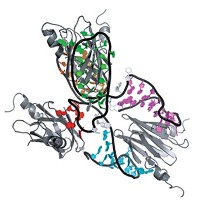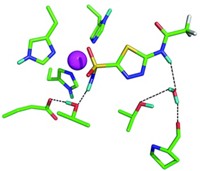Advertisement
Grab your lab coat. Let's get started
Welcome!
Welcome!
Create an account below to get 6 C&EN articles per month, receive newsletters and more - all free.
It seems this is your first time logging in online. Please enter the following information to continue.
As an ACS member you automatically get access to this site. All we need is few more details to create your reading experience.
Not you? Sign in with a different account.
Not you? Sign in with a different account.
ERROR 1
ERROR 1
ERROR 2
ERROR 2
ERROR 2
ERROR 2
ERROR 2
Password and Confirm password must match.
If you have an ACS member number, please enter it here so we can link this account to your membership. (optional)
ERROR 2
ACS values your privacy. By submitting your information, you are gaining access to C&EN and subscribing to our weekly newsletter. We use the information you provide to make your reading experience better, and we will never sell your data to third party members.
Materials
NMR Pins Down RNA Excited States
Structural Biology: Method captures short-lived, low-abundance RNA excited states
by Celia Henry Arnaud
October 15, 2012
| A version of this story appeared in
Volume 90, Issue 42

Scientists have long suspected that many RNA molecules have short-lived, low-abundance excited states, but those states have been difficult to characterize. Now, Hashim M. Al-Hashimi and coworkers at the University of Michigan, Ann Arbor, have developed a method to trap and observe these RNA excited states (Nature, DOI: 10.1038/nature11498).
The excited states typically last for microseconds and account for less than 5% of the population of a particular RNA molecule. Nonetheless, these alternative structures can significantly affect biological function, Al-Hashimi says.
“We’ve known for a long time that molecular dynamics are incredibly important in biology,” says Samuel E. Butcher, a biochemistry professor at the University of Wisconsin, Madison, who has previously observed an RNA excited state. “It just makes sense that RNA should have excited states. Al-Hashimi and coworkers have given us some of the first views of RNA excited-state structures.”
The researchers identify excited-state candidates using an RNA structure prediction program. For a given RNA sequence, they select the second-best structure as a possible excited state. (They assume the best structure is the ground state.) They mutate the RNA molecule to capture the predicted excited-state form. They then use nuclear magnetic resonance spectroscopy to determine the trapped form’s “chemical shift fingerprint,” which they compare with an excited-state-related fingerprint derived from chemical broadening in the NMR spectrum of the ground state. If the fingerprints match, they assume they have found the right structure.
The researchers used their method to identify excited-state structures for three RNA molecules—the apical loop of the transactivation response element (TAR) from HIV-1, which activates viral replication; the ribosomal A-site, which is involved in decoding messenger RNA; and HIV-1 stem-loop 1 (SL1), which is involved in dimerization of the viral genome.
In each case, the excited state involves small changes in base pair alignment. “The excited state typically sequesters bases that were otherwise exposed,” Al-Hashimi says. “In the ground state, these bases are available to interact with things. In the excited state, they’re not.”
The three systems involve different types of RNA secondary structures—a hairpin for TAR and internal loops for the A-site and SL1. “These motifs are very common and widespread in RNA,” Al-Hashimi says. “The fact that we see these excited states in these different motifs suggests that they’re probably a very general feature of RNA.”
The excited states “may serve as important starting targets for drug design and certainly for understanding the range of functions these molecules perform,” says Lewis E. Kay, a biochemistry professor at the University of Toronto. “Most of structural biology has focused to date on the ground states of biomolecules. It is clear that an understanding of function will require structural studies of additional conformations as well. This work takes an important step in that direction.”




Join the conversation
Contact the reporter
Submit a Letter to the Editor for publication
Engage with us on Twitter